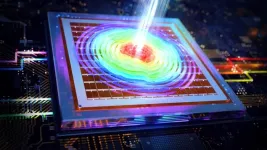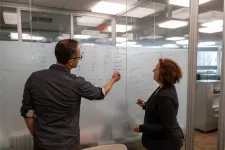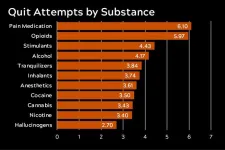(Press-News.org) ITHACA, N.Y. – In the same way that terrestrial life evolved from ocean swimmers to land walkers, soft robots are progressing, too, thanks to recent Cornell University research in battery development and design.
A modular worm robot and jellyfish demonstrate the benefits of “embodied energy” – an approach that incorporates power sources into the body of a machine, to reduce its weight and cost.
The worm and jellyfish are direct descendants of an aqueous soft robot, inspired by a lionfish and unveiled in 2019, that could store energy and power its applications via a circulating hydraulic fluid – i.e., “robot blood.” Similar blood sustains the new species, but with an improved design for greater battery capacity and power density.
“The jellyfish has much more capacity for its weight, so the duration it can travel is even longer than the fish,” said Rob Shepherd, professor of mechanical and aerospace engineering, who led both projects. “The worm is the first version we’ve done above ground. When it’s underwater, you get buoyantly supported, so you don’t need a skeleton. It doesn’t need to be rigid."
The key innovation of the worm robot was its compartmentalized design. The worm’s body is a series of interconnected pods, each containing a motor and tendon actuator so the worm can compress and expand its shape, as well as a stack of anolyte pouches immersed in catholyte.
“There are a lot of robots that are powered hydraulically, and we’re the first to use hydraulic fluid as the battery, which reduces the overall weight of the robot, because the battery serves two purposes, providing the energy for the system and providing the force to get it to move,” Shepherd said. “So then you can have things like a worm, where it’s almost all energy, so it can travel for long distances.”
The researchers tested two modes of movement. The worm can inch along the ground, with each pod contracting and then pushing itself forward; the worm can also push its way up and down a vertical pipe like a caterpillar, a technique known as two-anchor crawling.
The robot is not exactly speedy – it would take 35 hours to travel 105 meters in a single charging – but it is faster than other hydraulically powered worm bots. As for potential applications, the worm is particularly well suited for exploring long and narrow passageways, such as pipes, and possibly conducting repairs.
Likewise, the jellyfish robot would be an ideal low-cost tool for ocean exploration because it can be carried along with the current, then swim up to the surface to send and receive communications, before sinking back down.
The research was supported by the Office of Naval Research and the Department of Energy Basic Energy Sciences Program.
For additional information, read this Cornell Chronicle story.
Media note: Video of the jellyfish robot can be viewed and downloaded here: https://cornell.box.com/v/jellyfishrobot
-30-
END
‘Embodied energy’ powers modular worm, jellyfish robots
2025-01-27
ELSE PRESS RELEASES FROM THIS DATE:
Hebrew SeniorLife’s Deanna and Sidney Wolk Center for Memory Health recognized as an age-friendly health system
2025-01-27
Hebrew SeniorLife, New England’s largest nonprofit provider of senior health care and living communities and the only senior care organization affiliated with Harvard Medical School, announces that its Deanna and Sidney Wolk Center for Memory Health has been recognized by the Institute of Healthcare Improvement (IHI) as an Age-Friendly Health System, level 2, Committed to Care Excellence.
To qualify as an Age-Friendly Health System, level 2, the Wolk Center, which provides comprehensive outpatient care related to brain health, cognitive and behavioral problems, and memory loss, whether due to Alzheimer’s disease, other dementias, or other neurological or psychiatric ...
Scientists develop ultra-thin absorbers with record-breaking bandwidth
2025-01-27
Absorbing layers have been fundamental to advancements in technologies like energy harvesting, stealth systems, and communication networks. These absorbers efficiently capture electromagnetic waves across broad frequency ranges, enabling the development of sustainable, self-powered devices such as remote sensors and internet of things (IoT) systems. In addition to energy applications, these layers are pivotal in stealth technology, where they minimize radar visibility and enhance the performance of aircraft and naval systems. They also play a crucial role in improving communication networks by reducing ...
Floating solar increases greenhouse gas emissions on small ponds
2025-01-27
ITHACA, N.Y. – While floating solar – the emerging practice of putting solar panels on bodies of water – is promising in its efficiency and its potential to spare agricultural and conservation lands, a new experiment finds environmental trade-offs.
In the first manipulative field study examining the environmental impacts of floating solar, published in Environmental Science and Technology, researchers found that floating solar panels increased greenhouse gas emissions on small ponds by nearly 27%.
“There ...
Cancer risk established before birth
2025-01-27
GRAND RAPIDS, Mich. (Jan. 27, 2025) — A person’s lifetime risk for cancer may begin before they are even born, reports a paradigm-shifting study by Van Andel Institute scientists.
The findings, published in Nature Cancer, identified two distinct epigenetic states that arise during development and are linked to cancer risk. One of these states is associated with a lower lifetime risk while the other is associated with a higher lifetime risk.
If cancer does develop in the lower risk state, it ...
Sinking truths: University of Houston confirms Miami’s coastal subsidence challenges
2025-01-27
On the barrier islands of Miami, 35 skyscrapers – including Trump Tower III - have sunk as much as eight centimeters, or three inches, into the ground since 2016, and researchers from the University of Houston have played a pivotal role in uncovering the reason why – urban development.
The findings, published in Earth and Space Science, reveal alarming rates of subsidence – or land sinking – in coastal structures between 2016 and 2023.
According to the report, "About half of the subsiding structures are younger than 2014 and at the majority of them subsidence decays with ...
Sun receives funding for CyberCorps scholarship for service
2025-01-27
Kun Sun, Professor, Information Sciences and Technology, Center for Secure Information Systems, College of Engineering and Computing (CEC), received funding for: “CyberCorps Scholarship for Service: EAGLE: Empowering American Government Leadership in Cybersecurity through Education.”
Due to the proliferation of cyber-attacks, the ...
If at first you don’t succeed: Virginia Tech researchers ask how many attempts it takes to quit substance abuse
2025-01-27
Relapse is common when someone is trying to quit, regardless of whether they’re giving up opioids or alcohol or cigarettes.
To better inform treatment, researchers with the Fralin Biomedical Research Institute at VTC’s Addiction Recovery Research Center wanted to better understand how the experience of quitting differed across substances.
“When we talk about intervention for addiction, we know that we are far from the ideal model of treatment,” said Rafaela Fontes, a research scientist at the Fralin Biomedical Research Institute and first author on the study, “Beyond ...
Characterizing olfactory brain responses in young infants
2025-01-27
The sense of smell promotes adaptive behaviors such as feeding and soothing, but how early humans begin to process odors represents a gap in knowledge for researchers. In a new study in JNeurosci, Thorsten Kahnt from the National Institute on Drug Abuse and colleagues explored olfaction development in humans and reveal how early humans begin to smell. The researchers used fMRI to image the brains of sleeping infants as they inhaled appetitive (pleasant) and aversive (unpleasant) odors. As early as one month of age, odors triggered activity in brain regions strongly associated ...
Underwater mud volcanos are a haven for marine organisms
2025-01-27
The underwater volcano Borealis Mud Volcano is located in the Barents Sea and was first discovered by researchers at UiT The Arctic University of Norway in 2023. The discovery received a lot of attention, and images of the volcano circulated around the world. Now researchers from UiT, in collaboration with REV Ocean, have finally published the results from an interdisciplinary investigation showing that Borealis mud volcano has a unique ecological role as a natural sanctuary for several marine species in the Barents Sea.
While some parts of the ...
Adderall shortage may be associated with increased use of alternative ADHD medication in children
2025-01-27
A national shortage in a common treatment for attention-deficit hyperactivity disorder was associated with changes in stimulant prescriptions filled for children over recent years, a new study suggests.
The dispensing of prescription stimulants – a crucial therapy option for children with ADHD – fell sharply at the onset of the 2020 COVID pandemic but then began to recover, according to the research in Pediatrics.
The Federal Drug Administration’s announcement of a shortage in the stimulant Adderall in October ...





